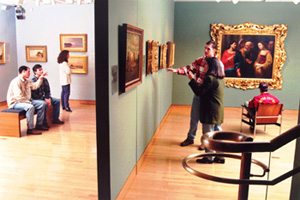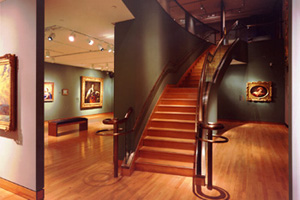BC infringes Pollocks?
 The Pollock-Krasner Foundation is still mulling how to respond to the decision by Boston College’s McMullen Museum of Art to reproduce several authenticated Jackson Pollock paintings in the catalogue for its exhibit “Pollock Matters” despite the objections of the foundation, which holds the copyrights to Pollock works. “The Foundation is currently reviewing the catalogue and considering its legal options,” the foundation’s executive vice president Kerrie Buitrago told The New England Journal of Aesthetic Research Wednesday via email.
The Pollock-Krasner Foundation is still mulling how to respond to the decision by Boston College’s McMullen Museum of Art to reproduce several authenticated Jackson Pollock paintings in the catalogue for its exhibit “Pollock Matters” despite the objections of the foundation, which holds the copyrights to Pollock works. “The Foundation is currently reviewing the catalogue and considering its legal options,” the foundation’s executive vice president Kerrie Buitrago told The New England Journal of Aesthetic Research Wednesday via email.The Globe’s intrepid Geoff Edgers broke this story on his blog early last week. The foundation had refused BC permission to print the artworks because they didn’t want suspect “Pollocks” in the exhibition mixing with real Pollocks.
Edgers says McMullen director Nancy Netzer explained BC's move by providing him this statement:
"Following the Pollock Krasner Foundation's decision to withhold permission to reproduce works of Lee Krasner and Jackson Pollock in the ‘Pollock Matters’ catalogue, Boston College worked closely with copyright counsel to produce a catalogue incorporating those images needed to publish our contributors' scholarship in conformity with fair use principles."The Pollock-Krasner Foundation’s Ron Spenser tells Edgers that he is troubled.
"They knew our reason, and they knew of our refusal," said Spencer. "For them to go ahead like this, it's strange, I wouldn't expect it from a public institution. If they thought they had a right to publish on a fair use basis, they could have told us this six months ago."I don’t know the caselaw, and I ain’t no lawman, but a straight reading of the law suggests Boston College, however rude its actions appear, may have a case.
 Section 107, “Limitations on Exclusive Rights: Fair Use,” says the reproduction of copyrighted work for “criticism, comment, news reporting, teaching … scholarship, or research, is not an infringement of copyright.” In particular, the law seems to give special allowance for “nonprofit educational purposes.”
Section 107, “Limitations on Exclusive Rights: Fair Use,” says the reproduction of copyrighted work for “criticism, comment, news reporting, teaching … scholarship, or research, is not an infringement of copyright.” In particular, the law seems to give special allowance for “nonprofit educational purposes.”It depends on how much of the copyrighted work you reproduce (BC reproduced whole works, though at a mighty small fraction of their actual size), and “The effect of the use upon the potential market for or value of the copyrighted work.” Could reproducing unauthenticated “Pollocks” with the real deal decrease the value of real Pollocks by potentially raising unfounded concerns about authenticity in the market for real Pollocks?
Still Boston College (and, say, blogs of art research) seem to meet a lot of the qualifications for fair use. And on the Web, where fair use is a major question, it’s an issue with broad resonance. Even if you just look locally, I suspect most of the local art blogs use images without permission of the copyright holders with some frequency. And, frankly, The New England Journal of Aesthetic Research (while crossing our fair-use fingers) on occasion does too (see bottom).
Pictured above: The galleries of Boston College's McMullen Museum. The New England Journal of Aesthetic Research did not get permission from Boston College to reproduce these photos from its website, but we worked closely with copyright counsel to produce a blog post incorporating those images needed to publish our research in conformity with fair use principles.






0 Comments:
Post a Comment
<< Home